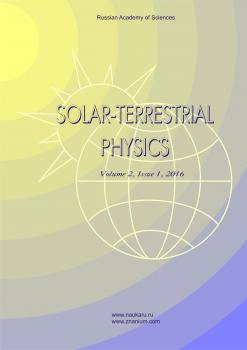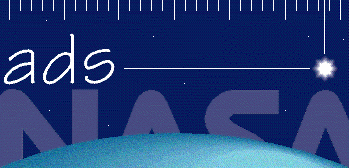Moskva, Russian Federation
Moskva, Russian Federation
Moscow, Russian Federation
Moscow, Russian Federation
We put forward a method of separating the geomagnetic activity contribution to the F2-layer critical frequency median, foF2med, at middle latitudes. It is based on the analysis of dfoF2, which is the ratio foF2med/foF2q in percent, where foF2q is the F2-layer critical frequency for quiet conditions. The quantities foF2q and dfoF2 depend on solar and geomagnetic activity respectively. These dependences are taken into account using indices F12 (the average over 12 months flux of solar radiation at 10.7 cm) and Apm (the average over a month value of Ap-index), thus facilitating the use of this method for forecasting foF2med. With this method, from Slough station (51.5° N, 0.6° W) data for midday and midnight for 1954 to 1995 we have found that at midnight the dfoF2 dependence on Apm is significant at the 95 % confidence level for equinoxes and summer. For midday, this dependence is less pronounced and is significant only from April to July. At equinoxes and summer, an Apm increase causes a dfoF2 decrease. For midnight, this feature is more pronounced than for midday. This regularity is valid also for annual average Apm and dfoF2.
midlatitude ionosphere, F2 layer, critical frequency, median, geomagnetic activity, regularity
1. Bilitza D., Altadill D., Zhang Y., Mertens C., Truhlik V., Richards P., McKinnell L.A., Reinisch B. The International Reference Ionosphere 2012 - a model of international collaboration. J. Space Weather Space Clim. 2014, vol. 4, A07. DOIhttps://doi.org/10.1051/swsc/2014004.
2. Bremer J. Trends in the ionospheric E and F regions over Europe. Ann. Geophysicae. 1998, vol. 16, no 8, pp. 986-996.
3. Buonsanto M.J. Ionospheric storms - a review. Space Sci. Rev. 1999, vol. 88. pp. 563-601. DOI:https://doi.org/10.1023/A: 1005107532631.
4. Caruana J. The IPS monthly T index. Solar-Terrestrial Prediction: Proc. Workshop at Leura, Australia (October 16-20, 1989). 1990, vol. 2, pp. 257-263.
5. Cliver E.W., Kamide Y., Ling A.G. The semiannual variation of geomagnetic activity: phases and profiles for 130 years of aa data. J. Atmos. Solar-Terr. Phys. 2002, vol. 64, no. 1, pp. 47-53. DOI:https://doi.org/10.1016/S1364-6826(01)00093-1.
6. Deminov M.G. Solar activity index for long-term ionospheric forecasts. Cosmic Research. 2016, vol. 54, no. 1, pp. 1-7. DOI:https://doi.org/10.1134/S0010952516010068.
7. Deminov M.G., Deminova G.F. What solar and geomagnetic activities does F2-layer critical frequency median correspond to in midlatitudes? Geomagn. Aeron. 2015, vol. 55, no. 3, pp. 326-332. DOI:https://doi.org/10.1134/S0016793215030068.
8. Deminov M.G., Zherebtsov G.A., Pirog O.M., Shubin V.N. Regular changes in the critical frequency of the F2 layer of the quiet midlatitude ionosphere. Geomagn. Aeron. 2009, vol. 49, no. 3, pp. 374-380. DOI:https://doi.org/10.1134/S0016793209030116.
9. Deminov M.G., Deminova G.F., Zherebtsov G.A., Polekh N.M. Statistical properties of variability of the quiet ionosphere F2-layer maximum parameters over Irkutsk under low solar activity. Adv. Space Res. 2013, vol. 51, no. 5, pp. 702-711. DOI:https://doi.org/10.1016/j.asr.2012.09.037.
10. Deminov M.G., Deminova G.F., Zherebtsov G.A., Polekh N.M. Properties of the F2-layer maximum density variability over Irkutsk under different levels of the solar and geomagnetic activity. Solnechno-zemnaya fizika [Solar-Terrestrial Physics]. 2015, vol. 1, iss. 1, pp. 56-62. DOI:https://doi.org/10.12737/6558. (in Russian).
11. Echer E., Gonzalez W.D., Gonzalez A.L.C., Prestes A., Vieira L.E.A., Dal Lago A., Guarnieri F.L., Schuch N.J. Long-term correlation between solar and geomagnetic activity. J. Atmos. Solar-Terr. Phys. 2004, vol. 66, no. 12, pp. 1019-1025. DOI:https://doi.org/10.1016/j.jastp.2004.03.011.
12. Fuller-Rowell T.J., Araujo-Pradere E., Codrescu M.V. An empirical ionospheric storm-time correction model. Adv. Space Res. 2000, vol. 25, no. 1, pp. 139-146. DOI:https://doi.org/10.1016/S0273-1177(99)00911-4.
13. Joselyn J.A. Geomagnetic activity forecasting: the state of the art. Rev. Geophys. 1995, vol. 33, no. 3, pp. 383-401. DOI:https://doi.org/10.1029/95RG01304.
14. Kutiev I., Muhtarov P. Modeling of midlatitude F region response to geomagnetic activity. J. Geophys. Res. 2001, vol. 106, no. A8, pp. 15501-15509. DOI: 10.1029/ 2001JA900018.
15. Kutiev I., Muhtarov P. Empirical modeling of global ionospheric foF2 response to geomagnetic activity. J. Geophys. Res. 2003, vol. 108, no. A1, 1021. DOI: 10.1029/ 2001JA009134.
16. Laštovička J., Mikhailov A.V., Ulich T., Bremer J., Elias A.G., Ortiz de Adler N., Jara V., Abarca del Rio R., Foppiano A.J., Ovalle E., Danilov A.D. Long-term trends in foF2: a comparison of various methods. J. Atmos. Solar-Terr. Phys. 2006, vol. 68, no. 17, pp. 1854-1870. DOI: 10.1016/ j.jastp.2006.02.009.
17. Liu R., Smith P., King J. A new solar index which leads to improved foF2 predictions using the CCIR atlas. Telecommun. J. 1983, vol. 50, no. 8, pp. 408-414.
18. Mielich J., Bremer J. Long-term trends in the ionospheric F2 region with different solar activity indices. Ann. Geophys. 2013, vol. 31, pp. 291-303. DOI:https://doi.org/10.5194/angeo-31-291-2013
19. Mikhailov A.V., Mikhailov V.V. A new ionospheric index MF2. Adv. Space Res. 1995, vol. 15, no. 2, pp. 93-97.
20. Picone J.M., Hedin A.E., Drob D.P., Aikin A.C. NRLMSISE-00 empirical model of the atmosphere: statistical comparisons and scientific issues. J. Geophys. Res. 2002, vol. 107, no. A12, 1468. DOI:https://doi.org/10.1029/2002JA009430.
21. Pietrella M. A short-term ionospheric forecasting empirical regional model (IFERM) to predict the critical frequency of the F2 layer during moderate, disturbed, and very disturbed geomagnetic conditions over the European area. Ann. Geophysicae. 2012, vol. 30, no. 2, pp. 343-355. DOI: 10.5194/ angeo-30-343-2012.
22. Pietrella M., Perrone L. A local ionospheric model for forecasting the critical frequency of the F2 layer during disturbed geomagnetic and ionospheric conditions. Ann. Geophysicae. 2008, vol. 26, no. 2, pp. 323-334. DOI: 10.5194/ angeo-26-323-2008.
23. Prolss G.W. Seasonal variations of atmospheric-ionospheric disturbances. J. Geophys. Res. 1977, vol. 82, no. 10, pp. 1635-1640. DOI:https://doi.org/10.1029/JA082i010p01635.
24. Ramachandran K.M., Tsokos C.P. Mathematical statistics with applications. Oxford, Elsevier Academic Press, 2009. 824 p.
25. Shubin V.N., Anakuliev S.K. Ionospheric storm negative phase model at middle latitudes. Geomagn. Aeron. 1995, vol. 35, no. 3, pp. 363-369.
26. Sole J.G. Relations between hourly monthly median values of foF2 and some geophysical indices. Their application to an ionospheric single station model. Acta Geophys. Polonica. 1998, vol. 46, no. 1, pp. 77-88.
27. Wrenn G.L. Time-weighted accumulations ap() and Kp(). J. Geophys. Res. 1987, vol. 92, no. A9, pp. 10125-10129. DOI:https://doi.org/10.1029/JA092iA09p10125.
28. Wrenn G.L., Rodger A.S. Geomagnetic modification of the mid-latitude ionosphere: toward a strategy for the improved forecasting of foF2. Radio Sci. 1989, vol. 24, no. 1, pp. 99-111. DOI:https://doi.org/10.1029/RS024i001p00099.
29. Xu T., Wu Z-S., Wu Jian, Wu Jun. Solar cycle variation of the monthly median foF2 at Chongqing station, China. Adv. Space Res. 2008, vol. 42, no. 1, pp. 213-218. DOI: 10.1016/ j.asr.2008.01.012.
30. Zolesi B., Cander L.R. Ionospheric Prediction and Forecasting. Berlin, Heidelberg, Springer-Verlag, 2014, 240 p. DOI:https://doi.org/10.1007/978-3-642-38430-1.
31. URL: http://spidr.ngdc.noaa.gov (accessed 30.06.2017).
32. URL: http://www.ukssdc.ac.uk/wdcc1 (accessed 11.06.2017)
33. URL: http://wdc.kugi.kyoto-u.ac.jp (accessed 01.07.2017)

















